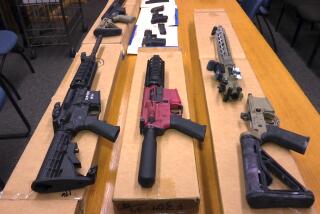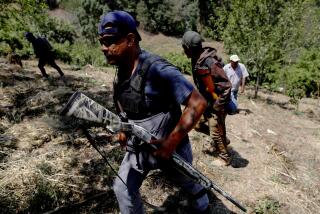‘Ghost guns’ are easy to build, legal and completely untraceable

In just the past few years, the advancement and availability of milling and 3-D printing technology has made it easier than ever to build your own guns.
- Share via
SAN DIEGO — Every gun tells a story.
It’s a popular catchphrase used by law enforcement to describe how to trace a firearm, from manufacturer to distributor to point of sale to customer.
But a new crop of guns bear no markings of their origin.
They are hand-built in homes and shared workshops, using mail-order parts and drilling machines that range from the rudimentary to the complex. They don’t bear the serial numbers of licensed manufacturers. They are untraceable, hence their nickname: “ghost guns.”
In just the past few years, the advancement and availability of milling and 3-D printing technology has made it easier than ever to build your own guns.
While not illegal on the face of it, authorities have grown increasingly concerned about the potential for a growing black market that sidesteps state and federal gun laws regulating everything from background checks to banned weapons.
The build-your-own-gun movement took off a few years ago in California, home to some of the strictest gun laws in the nation, and has more recently been spreading to other part of the country, said Paul Ware, counsel for the Los Angeles division of the U.S. Bureau of Alcohol, Tobacco, Firearms and Explosives. The division spans Southern California, from the Mexico border north to San Luis Obispo.
Ware first heard of the practice a few years ago when an investigator forwarded him a clip from San Diego’s 10 News. A local business was inviting people to make their own AR-15-type weapons around Christmastime. While state law prohibits the sale of the completed rifles, it is not illegal to posses them in specific configurations. A new state law also requires AR-15 owners to register their weapons.
“I watched the video and said ‘That’s interesting,’” Ware said. He researched further and determined the business didn’t have a firearms manufacturing license, which is needed to make guns for sale legally.
“They are no longer in business,” he said. “We told them they needed a license, and they decided not to get a license.”

By law, licensed gun manufacturers are required to engrave identifying information on the weapon’s lower receiver. It’s the hollow metal frame that by legal definition makes a gun a gun. The manufacturer name and unique serial number are marked on the piece, and the gun’s path to a distributor is recorded in its company records.
The distributor and gun dealer must also record their possession of the weapon, ending with to whom the gun is ultimately sold.
ATF is prohibited by law from keeping a national register of firearms, so when a gun pops up at a crime scene, it is this process of checking through private corporate records that traces the gun to potential suspects.
When a ghost gun shows up at a crime scene, that presents a problem.
How does it work?
The most important component to building an untraceable gun is the lower receiver. The easiest way to get one without the markings of a licensed manufacturer is to buy an unfinished lower receiver online.
Called ULR for short, the unfinished piece can be sold legally without a license as long as it is missing key components that make it a firearm. The gun industry has attached a threshold to this, typically describing an unfinished lower receiver as 80 percent done. But ATF says that there is no 80 percent rule — it either is a gun or isn’t a gun, Ware said.
Once at home, the buyer can easily drill a few remaining holes in the unfinished metal shell. The now-finished lower receiver is then ready for its other parts — such as barrel, trigger mechanism, upper receiver and stock — all readily available online. Assemble it and you’ve got a working gun.
Lower receivers can also be milled from scratch at shared workshops that rent expensive machinery to the public.
It is not illegal to make or own these kinds of guns, and gun enthusiasts make up much of the fanbase for this do-it-yourself method.
“It’s not as nefarious as it sounds,” said Steve Herrick, owner of MakerPlace in Morena, a workshop that rents everything from metalworking tools to 3-D printers to industrial sewing machines.
He said customers bring in their own computer software for the Computer Numeric Control, or CNC, machines, where they can make anything from a Barbie to a lower receiver.
“The work required is not that hard. You don’t have to be a skilled craftsman to do those things,” he said.
He added: “We try not to stick our nose in our customers’ business.”
The one rule he asks gunmakers to follow is to not ever assemble the firearm at the workshop. “They can make individual parts, most of which are not recognizable,” Herrick said.
The guns are a far cry from the first models that were milled this way, Ware said.
“People laughed off the first versions of 3-D guns, they were terrible,” he said. “They shot a few rounds, blew up in your hand. It’s not that anymore. They are nearly as good as ones you can buy.”
Against the law
What is illegal is to make these kinds of guns for sale, or to sell as a middleman. And a felon is prohibited from owning any kind of gun.
A black market for these untraceable guns — from Glock pistols to fully-automatic machine guns — has emerged, selling to customers without background checks.
“Prohibited people have easy access to these guns,” Ware said. “They can make them themselves or buy from someone who makes it for them. It subverts the whole Gun Control Act. Most people think it’s hard to get a gun without a background check. It’s not.”
It was easy for Rolando Magana.
Prior convictions for domestic violence and making threats using a gun made him ineligible to own a firearm. So he went to ROHG Industries.
“They were inviting the public to come in, you pick the parts you want, like a smorgasbord, a buffet,” Ware said. “They put it into the CNC machines and ask the customer to press the button. Believe it or not, they could manufacture and fully assemble a gun, in an hour, you walk out with a rifle.”
The La Habra business kept records of its sales and photos of customers, but did not perform background checks, authorities allege. When the warehouse was searched in 2014, agents culled through about 520 customer profiles and learned 20 were convicted felons and another person was deemed mentally unfit to possess a gun, according to court documents.
One of those customers, Magana, admitted that he’d bought guns and gun parts from the business and trafficked them in carloads to Michoacan, Mexico, according to the criminal complaint. A search of his house turned up an arsenal of guns marked with serial numbers, as well as unfinished lower receivers and plastic human restraints.
The warehouse owner, Joseph Roh, is set to go to trial in October in Orange County on a charge of manufacturing guns without a license.
Paul Joseph Holdy, a convicted felon with a history of drug offenses, was running a less sophisticated operation in San Diego.
Using drill presses and small CNC machine at his University City home, as well as the fancier machines at MakerPlace, Holdy made lower receivers and then assembled guns using component parts. He sold at least 18 guns to undercover ATF agents from June 2016 to May 2017, including short-barrel machine guns, assault rifles and handguns, according to his plea agreement and other court records.
The deals were often made in parking lots, and a few times the agents were invited to the house that he shared with his parents, according to court records.
Another local ring ran out of North County. A young mechanic, Christian Romero, was accused of making assault-style weapons from unfinished lower receivers and then selling the assembled weapons with help from friends for more than $1,000 each.
While federal authorities went after these operations criminally, ATF’s Ware said the agency tries to first educate those in the industry about what is and isn’t allowed. Most comply, he said.
ATF does not specifically track cases involving unfinished lower receivers, therefore it is unknown how frequently such guns are showing up at crime scenes or are seized. Local law enforcement are more likely to come across such weapons, Ware said.
San Diego police said officers rarely come across such guns.
An AR-15-style rifle pieced together from various parts was used in the 2013 rampage shooting in Santa Monica. John Zawahri, 23, killed five people, starting at his father’s home and ending at Santa Monica College. Police shot him in the school’s library. Zawahri was also carrying a .44-caliber pistol.
The rifle appeared to have been modified to fire more rounds.
Twitter: @kristinadavis
More to Read
Sign up for Essential California
The most important California stories and recommendations in your inbox every morning.
You may occasionally receive promotional content from the Los Angeles Times.











